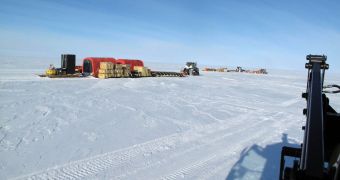Officials at the National Science Foundation and NASA gave the final go-ahead for the launch of a new scientific research campaign on Pine Island Glacier, in Antarctica. The joint research team that will conduct the work is scheduled to be deployed on the field in mid-December.
Pine Island Glacier is one of the most active ice sheets on the entire Southern Continent, moving at great speed, and producing new icebergs at a relatively high rate. In addition to NASA and NOAA experts, the group will also include scientists from other universities around the world.
One of the most important objectives the mission has is determining precisely how much heat oceanic waters surrounding the ice sheet deliver to its underside. This is important for determining why such large icebergs are produced at great speeds.
Based on these data, the team will attempt to develop reliable new models for predicting the acceleration rates of glacier in Antarctica. This will in turn help them estimate how ice sheets contribute to sea level rise around the world.
The NSF will coordinate the entire American segment of the research initiative, since it is in charge of managing the United States Antarctic Program. The latter covers Antarctica and the Southern Ocean.
“Pine Island Glacier has begun to flow more rapidly, discharging more ice into the ocean, which could have a significant impact on global sea-level rise over the coming century,” Scott Borg explains.
“This project, which aims to determine the underlying causes of this phenomenon, illustrates the fact that research conducted in Antarctica contributes to knowledge that benefits society in general,” the investigator goes on to say.
Borg holds an appointment as the director of the NSF Division of Antarctic Sciences. He explains that the scientist will use both traditional tools and sophisticated new oceanographic instruments to determine the amount of heat the ocean is delivering underneath the large ice sheet.
Pine Island Glacier alone is releasing more than 19 cubic miles (79.2 cubic kilometers) of ice into the Southern Ocean each year, and it is not, by far, the only ice sheet to calve into the water, or the largest.
“The scale of a project required to comprehend the dynamics of something as large and complex as the forces acting on the Pine Island Glacier also emphasizes the increasing need for agencies such as NASA and NSF to collectively bring their expertise to bear on common goals,” Borg adds.
“It also highlights the important work done by the nation's colleges and universities with NSF support. This is a major undertaking but it promises very interesting and very important results,” he concludes.

 14 DAY TRIAL //
14 DAY TRIAL //